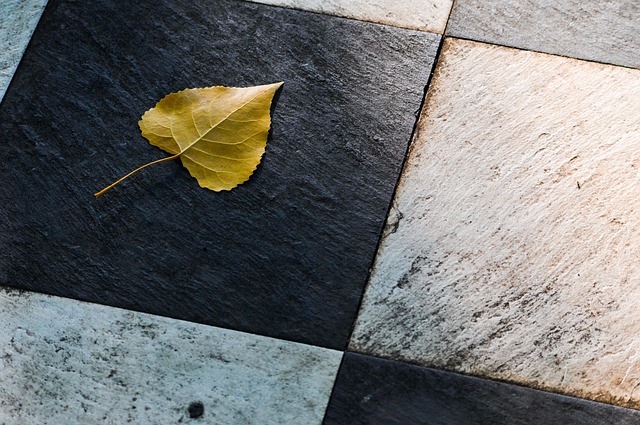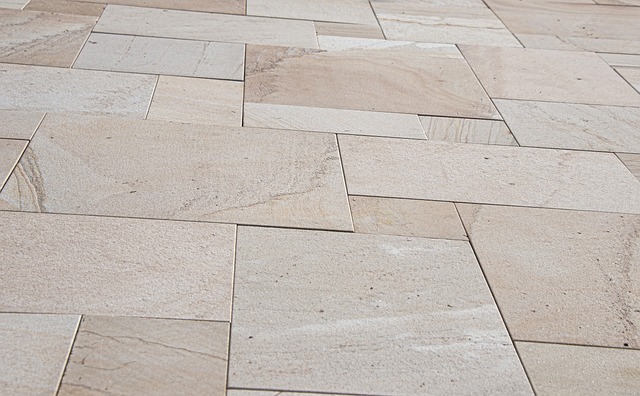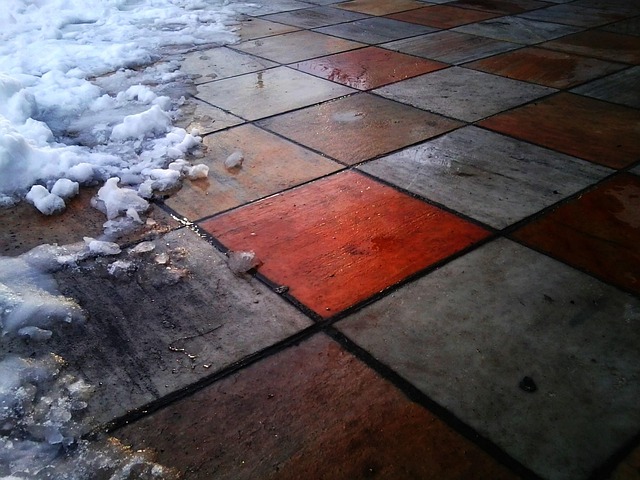The article provides an in-depth guide on maintaining and cleaning tile floors, emphasizing best practices to ensure longevity and aesthetic appeal. Key points include:
– Regular Vacuuming: Essential for removing dirt from grout lines using a powerful vacuum with a brush attachment.
– pH-Neutral Cleaning: Important for soft stones; milder detergents suitable for ceramic and porcelain with finish protection.
– Steam Cleaning: A deep cleaning method that removes dirt, stains, and grime efficiently and eco-friendly.
– Tailored Scrubbing Techniques: Using appropriate tools and solutions for everyday dirt or stubborn marks like oil and pet accidents.
– Preventing Damage: Minimizing water exposure, using suitable cleaning tools, and prompt spot treatment to preserve tile integrity.
– Regular Mopping: Daily sweeping/vacuuming, mild detergents, and regular mopping with warm water maintain tiles and grout.
– Professional Help: Seeking experts for stubborn dirt or deep cleaning when standard supplies are ineffective.
Looking for sparkling tile floors? Discover the best methods for cleaning tile floors with our comprehensive guide. We’ll explore everything from understanding different tile types and common issues, to the importance of a regular cleaning routine. Learn effective vacuuming techniques, choose the right detergents, and master steam cleaning for deep results. Plus, find tips on scrubbing tough stains, preventing damage, maintaining longevity, and when to consider professional tile cleaning services.
Understanding Tile Floors: Types and Common Issues

Tile floors come in a variety of materials and styles, each with its unique characteristics and care requirements. From ceramic to porcelain, natural stone to vinyl, understanding these different types is crucial for effective cleaning. Over time, tile floors can accumulate dirt, grime, stains, and even mold, especially in high-traffic areas or regions with poor ventilation. Common issues include grout lines becoming discolored, tiles losing their shine, and the accumulation of soap scum and hard water stains. Identifying these problems early on is key to maintaining a clean and aesthetically pleasing tile floor.
The best methods for cleaning tile floors involve regular vacuuming or sweeping to remove loose debris, followed by a thorough mopping using a pH-neutral cleaner to address stains and grime. For more stubborn stains, a combination of mild bleach and water or specialized tile cleaners can be effective. Proper drying after cleaning is essential to prevent the growth of mold and bacteria. Additionally, sealing grout lines regularly helps to protect against future staining and makes maintenance easier.
The Importance of Regular Cleaning Routine

Maintaining a regular cleaning routine for your tile floors is essential, as it helps to preserve their longevity and aesthetic appeal. Over time, tiles can accumulate dirt, stains, and grime, especially in high-traffic areas. The best methods for cleaning tile floors involve a combination of proactive measures and effective cleaning techniques. Regular mopping with a suitable tile floor cleaner can prevent the buildup of debris and maintain the surface’s shine.
Additionally, using the right tools is crucial; microfiber mops and squeegees are ideal as they reduce water damage and ensure a thorough clean. For more stubborn stains, employing specialized tile cleaning solutions tailored to different types of tiles can make a significant difference. Regular deep cleaning sessions not only enhance the visual appeal but also extend the life of your tiles, making them look as good as new for years to come.
Best Vacuuming Techniques for Effective Debris Removal

When it comes to best methods for cleaning tile floors, vacuuming is a crucial step for effective debris removal. The key is to use techniques that go beyond surface scrubbing. Start by using a vacuum with a powerful suction and a brush attachment designed for hard surfaces. This helps dislodge dirt and grime from the grout lines and nooks where a regular broom or mop might not reach.
For optimal results, vacuum in multiple directions—back-and-forth motions can push debris deeper into the tile and grout. Additionally, consider the frequency of vacuuming based on traffic areas. High-traffic zones require more frequent cleaning to prevent buildup. Regular, thorough vacuuming is a fundamental practice for maintaining pristine tile floors.
Choosing the Right Detergents for Different Tile Surfaces

When it comes to cleaning tile floors, selecting the appropriate detergent is key to achieving optimal results and preserving different surface types. Different tiles, from ceramic to porcelain or natural stone, have unique properties that require tailored care. Using the best methods for cleaning tile floors involves understanding these nuances. For instance, softer stones like marble or travertine may be susceptible to etching from aggressive chemicals, necessitating pH-neutral cleaners.
In contrast, ceramic and porcelain tiles often handle stronger detergents better but still require consideration for finish protection. Enamelled or glazed tiles can withstand high-pH solutions for removing stubborn stains, while unglazed tiles might need milder options to prevent damage. The best approach is to consult manufacturers’ guidelines and opt for detergent brands that specialize in tile cleaning, ensuring the safety and longevity of your flooring.
Steam Cleaning: A Powerful Method for Deep Cleaning

Steam cleaning has emerged as one of the best methods for deep cleaning tile floors, offering a powerful and efficient solution for removing dirt, stains, and grime. This technique utilises high-pressure steam to penetrate the pores of the tiles, breaking down and dissolving tough residues. The result is not just a sparkling clean surface but also a deeper level of sanitisation as steam kills bacteria, viruses, and fungi, ensuring a hygienic environment.
Compared to traditional cleaning methods, steam cleaning offers several advantages. It’s eco-friendly, as it uses only water and no harsh chemicals. This makes it safer for both your family and pets. Additionally, it’s highly effective in tackling hard-to-reach areas and corners, ensuring every inch of your tiled surface is thoroughly cleaned.
Scrubbing Techniques for Tough Stains and Grout

When it comes to tackling tough stains and grout on tile floors, knowledge is power. The best methods for cleaning tile floors involve understanding various scrubbing techniques tailored to different types of stains. For example, gently brushing with a soft-bristled brush and a mild detergent can effectively remove everyday dirt and grime, keeping your tiles sparkling.
For more stubborn marks, like those from oil, wine, or pet accidents, a combination of warm water, vinegar, and baking soda creates a powerful cleaning solution. Scrubbing in a back-and-forth motion with a stiff nylon brush will help lift the stain. In areas with grout, don’t forget to use a specialized grout cleaner to penetrate and remove deep-set dirt, ensuring your entire floor looks as good as new.
Preventing Damage During Tile Cleaning Process

When it comes to tile cleaning, preventing damage is as crucial as achieving a spotless finish. The best methods for cleaning tile floors involve understanding and adhering to specific practices that safeguard your tiles’ integrity. One of the primary concerns is avoiding excessive water exposure, as prolonged moisture can lead to grout erosion and potential tile damage over time. Therefore, using the right cleaning tools and products is essential; opt for mops or buckets with built-in drainage systems to minimize water residuals on the surface.
Additionally, many professional tile cleaning services employ gentle yet effective solutions tailored for different tile types. Using aggressive chemicals or abrasive scrubbers can scrape off protective coatings and damage delicate finishes. Instead, focus on eco-friendly, pH-neutral cleaners that cut through dirt effectively without leaving behind harsh residue. Regular spot treatment and addressing stains promptly also contribute to preserving the tiles’ appearance and longevity.
Tips for Maintenance and Longevity of Tile Floors

To maintain tile floors and ensure their longevity, regular cleaning is essential using the best methods for cleaning tile floors. Begin by sweeping or vacuuming daily to remove loose dirt and debris, preventing dust and grime from settling into the grout lines and tiles. This simple step goes a long way in preserving the overall cleanliness and aesthetics of your tiled surfaces.
Additionally, consider using a mild detergent or pH-neutral cleaner suitable for tiles and grout. Avoid harsh chemicals that can damage the tile finish and weaken grout bonds. Regularly mop the floors with warm water and the chosen cleaning solution, rinsing thoroughly afterward to eliminate any residue. This practice helps remove stains, prevents buildup, and keeps your tile floors looking fresh.
Professional Tile Cleaning Services: When to Consider Experts

When it comes to maintaining the cleanliness and aesthetics of your tile floors, knowing when to seek professional help is essential. While regular cleaning routines can keep tiles looking good, there are instances where the best methods for cleaning tile floors involve enlisting expert services. These professionals are equipped with advanced tools and techniques that go beyond standard home cleaning supplies.
Expert tile cleaners have access to specialized equipment like high-pressure washers, steam cleaners, and powerful vacuums designed specifically for tile and grout. They understand the various types of tiles and stains, allowing them to tailor their approach accordingly. Whether it’s removing stubborn dirt, deep-cleaning grout lines, or treating tough stains, professionals can restore your tile floors to their original beauty, ensuring a longer lifespan and maintaining that fresh, appealing appearance.
